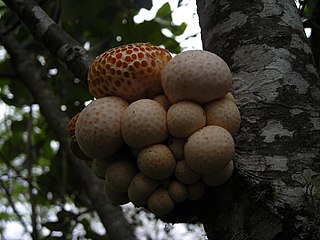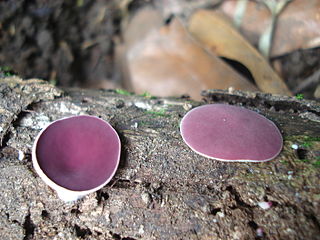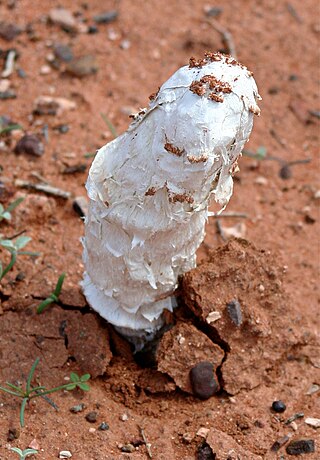Related Research Articles

Mycology is the branch of biology concerned with the study of fungi, including their taxonomy, genetics, biochemical properties, and use by humans. Fungi can be a source of tinder, food, traditional medicine, as well as entheogens, poison, and infection.

Microsporidia are a group of spore-forming unicellular parasites. These spores contain an extrusion apparatus that has a coiled polar tube ending in an anchoring disc at the apical part of the spore. They were once considered protozoans or protists, but are now known to be fungi, or a sister group to fungi. These fungal microbes are obligate eukaryotic parasites that use a unique mechanism to infect host cells. They have recently been discovered in a 2017 Cornell study to infect Coleoptera on a large scale. So far, about 1500 of the probably more than one million species are named. Microsporidia are restricted to animal hosts, and all major groups of animals host microsporidia. Most infect insects, but they are also responsible for common diseases of crustaceans and fish. The named species of microsporidia usually infect one host species or a group of closely related taxa. Approximately 10 percent of the species are parasites of vertebrates —several species, most of which are opportunistic, can infect humans, in whom they can cause microsporidiosis.

Miles Joseph Berkeley was an English cryptogamist and clergyman, and one of the founders of the science of plant pathology. The standard author abbreviation Berk. is used to indicate this person as the author when citing a botanical name.

Clitocybe is a genus of mushrooms characterized by white, off-white, buff, cream, pink, or light-yellow spores, gills running down the stem, and pale white to brown or lilac coloration. They are primarily saprotrophic, decomposing forest ground litter. There are estimated to be around 300 species in the widespread genus.

Boletus is a genus of mushroom-producing fungi, comprising over 100 species. The genus Boletus was originally broadly defined and described by Carl Linnaeus in 1753, essentially containing all fungi with hymenial pores instead of gills. Since then, other genera have been defined gradually, such as Tylopilus by Petter Adolf Karsten in 1881, and old names such as Leccinum have been resurrected or redefined. Some mushrooms listed in older books as members of the genus have now been placed in separate genera. These include such as Boletus scaber, now Leccinum scabrum, Tylopilus felleus, Chalciporus piperatus and Suillus luteus. Most boletes have been found to be ectomycorrhizal fungi, which means that they form a mutualistic relationship with the roots system of certain kinds of plants. More recently, Boletus has been found to be massively polyphyletic, with only a small percentage of the over 300 species that have been assigned to Boletus actually belonging there and necessitating the description and resurrection of many more genera.

Omphalotus nidiformis, or ghost fungus, is a gilled basidiomycete mushroom most notable for its bioluminescent properties. It is known to be found primarily in southern Australia and Tasmania, but was reported from India in 2012 and 2018. The fan or funnel shaped fruit bodies are up to 30 cm (12 in) across, with cream-coloured caps overlain with shades of orange, brown, purple, or bluish-black. The white or cream gills run down the length of the stipe, which is up to 8 cm (3 in) long and tapers in thickness to the base. The fungus is both saprotrophic and parasitic, and its fruit bodies are generally found growing in overlapping clusters on a wide variety of dead or dying trees.

Cyttaria is a genus of ascomycete fungi. About 10 species belong to Cyttaria, found in South America and Australia associated with or growing on southern beech trees from the genus Nothofagus. The "llao llao" fungus Cyttaria hariotii, one of the most common fungi in Andean-Patagonian forests, has been shown to harbor the yeast Saccharomyces eubayanus, which may be source of the lager yeast S. pastorianus cold-tolerance. Cyttaria was originally described by mycologist Miles Joseph Berkeley in 1842.

Polyozellus is a fungal genus in the family Thelephoraceae, a grouping of mushrooms known collectively as the leathery earthfans. Previously considered a monotypic genus, it now contains the Polyozellus multiplex species complex. The genus name is derived from the Greek poly meaning many, and oz, meaning branch. It is commonly known as the blue chanterelle, the clustered blue chanterelle, or, in Alaska, the black chanterelle. The distinctive fruit body of this species comprises blue- to purple-colored clusters of vase- or spoon-shaped caps with veiny wrinkles on the undersurface that run down the length of the stem.

The Onygenaceae are a family of fungi in the Ascomycota, class Eurotiomycetes.
Skepperia is a genus of fungi in the family Thelephoraceae. The genus was described by mycologist Miles Joseph Berkeley in 1857 to contain the type species Skepperia convoluta. The genus was circumscribed by Berkeley in Trans. Linn. Soc. London vol.22 on page 130 in 1857.

Phillipsia is a genus of fungi in the family Sarcoscyphaceae. There are about 17 species in the genus, which collectively have a widespread distribution in subtropical and tropical areas. The genus was circumscribed by Miles Joseph Berkeley in 1881. The generic name honours Wales-born English botanist William Phillips (1822–1905).

Agaricus deserticola, commonly known as the gasteroid agaricus, is a species of fungus in the family Agaricaceae. Found only in southwestern and western North America, A. deserticola is adapted for growth in dry or semi-arid habitats. The fruit bodies are secotioid, meaning the spores are not forcibly discharged, and the cap does not fully expand. Unlike other Agaricus species, A. deserticola does not develop true gills, but rather a convoluted and networked system of spore-producing tissue called a gleba. When the partial veil breaks or pulls away from the stem or the cap splits radially, the blackish-brown gleba is exposed, which allows the spores to be dispersed.

Amanita strobiliformis is a species of mushroom. It is commonly referred to as warted amanita.

Phellorinia is a genus of fungi in the family Phelloriniaceae of the order Agaricales. The genus is monotypic, and contains the single species Phellorinia herculeana, described by English naturalist Miles Joseph Berkeley in 1843 as P. inquinans. This single species has currently 24 synonyms, and takes its epithet from the basionym Scleroderma herculeanum Pers.
Nothocastoreum is a fungal genus in the Mesophelliaceae family. The genus is monotypic, containing the single truffle-like species Nothocastoreum cretaceum, found in Australia.

Amanita ananiceps is a species of agaric fungus in the family Amanitaceae native to Australia.
References
- ↑ "Mesophellia Berk. 1857". MycoBank. International Mycological Association. Retrieved 2011-11-19.
- ↑ Kirk PM, Cannon PF, Minter DW, Stalpers JA (2008). Dictionary of the Fungi (10th ed.). Wallingford, UK: CABI. p. 419. ISBN 978-0-85199-826-8.
- ↑ Berkeley MJ. (1857). "On some new fungi" (PDF). Transactions of the Linnean Society of London. 22 (2): 129–31. doi:10.1111/j.1096-3642.1856.tb00086.x.